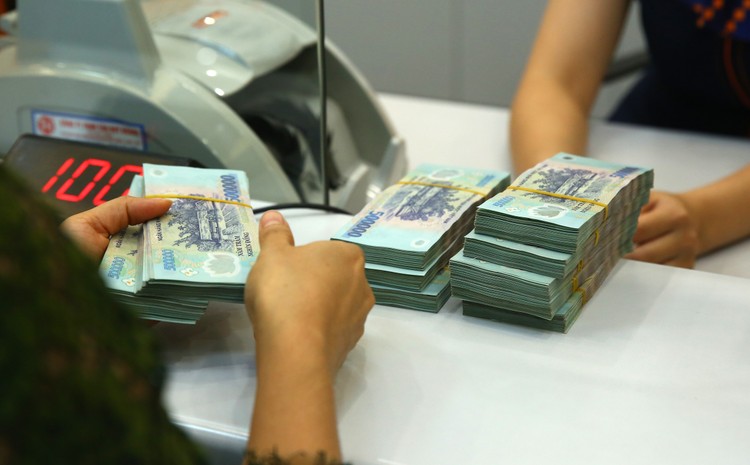Bad bank debts are being exposed one by one.
For the third quarter of 2023, certain commercial banks reported low bad debt ratios in their financial reports. Meanwhile, State Bank of Vietnam (SBV) statistics shows that the overall bad debt ratio is rising dramatically. Bad debt reduction efforts, according to these critics, are and will continue to encounter formidable obstacles so long as enterprises must contend with an unfriendly business climate and numerous dangers stemming from global geopolitical upheavals.
Since many companies have been given extensions and have not yet changed debt groups in accordance with Circular 02/2023/TT-NHNN Illustration photo: Tien Giang, it is possible that the bad debt ratio of banks is much greater than the reported amount.
Since many companies have been given extensions and have not yet changed debt groups in accordance with Circular 02/2023/TT-NHNN Illustration photo: Tien Giang, it is possible that the bad debt ratio of banks is much greater than the reported amount.
Bac Profit after tax for the third quarter of 2023 was 444 billion Vietnamese Dong (VND), while bad debt at the end of September 2023 was 762 billion Vietnamese Dong (VND), an increase of 83 billion VND from the end of the second quarter of 2023. Beginning in 2022 at 0.55%, the Bank's bad debt ratio climbed to 0.7% at the end of the second quarter of 2023 and to 0.7% by the end of the third quarter of 2023.
The bad debt/loan balance ratio increased from 2.12% at the beginning of the year to 2.23% by the end of the third quarter of 2023, according to the financial report of Saigon Bank for Industry and Trade (Saigonbank). Saigonbank's principle debt of the risk-resolved debt currently under monitoring is VND 1,813 billion as of September 30, 2023, according to the notes to the financial statements; the interest debt of the debt that has had its risks resolved throughout the monitoring period is VND 3,437 billion.
The bad debt at PG Bank reached 796 billion VND at the end of September 2023, up 51 billion VND from the beginning of the year, and the bad debt to loan balance ratio rose to 2.61% from 2.56%. Towards the end of the third quarter of 2023.
According to the State Bank's survey of business trends in the fourth quarter of 2023 of credit institutions, the ratio of bad debts/credit balance usage increased "slightly" in the third quarter of 2023 but is expected to decrease "slightly" in the fourth quarter.
Credit institutions predict that the overall risk level of client groups would increase slightly in the third quarter and the fourth quarter of 2023, albeit at a slower growth rate compared to the previous quarter. It is anticipated that the level of risk would increase substantially in 2023 compared to 2022, but that it may drop marginally in 2024. In addition, 63 percent of financial institutions place the total risk of consumer groups at "" average," while 4.6 percent place it at "low," and 32.4 percent place it at "high" or "very high."
Bad debt as of the most recent State Bank update (July 2023) stands at 3.56%, higher than the 2% at the end of 2022 and the 1.69% at the end of 2020. Ratio of Debt to Income In terms of percentage of total debt, bad debts on the balance sheet, unprocessed debt sold to Vietnam Asset Management Company Limited (VAMC), and potential debt of the system of credit institutions make up 6.16 percent.
The State Bank predicts that several factors will continue to put pressure on the credit quality of the credit institution system in the near future. Thus, developments in the domestic and international macroeconomic situation have many drawbacks, including negative effects on production and business activities, debt repayment capabilities of customers, an increase in bad debt, and increased pressure on customers. in establishing provisions to deal with bad debts and the development of dealing with collateral assets of bad debts of credit institutions.
As Governor of the State Bank Nguyen Thi Hong told the National Assembly Standing Committee on October 16th, there are still many challenges in the process of addressing bad loans because of the detrimental impacts on enterprises. Debt repayment capacity is lowered when the external situation is unfavorable. Furthermore, there is a lack of preferred methods and policies to attract domestic and foreign investors to participate in financial settlement, and the regulatory framework connected to restructuring credit institutions and addressing bad debts has not been finalized. Bad debt and other secured asset transactions. Notably, poor liquidity in the real estate market persists, creating challenges when dealing with secured assets. The real estate industry's bad debt percentage is on the rise, having increased from 1.8% in July 2022 to 2.58% in July 2023.
According to Ho Chi Minh City University of Economics lecturer Dr. Nguyen Huu Huan, the rise in bad debt is indicative of the current scenario and strain on the financial sector as a result of the challenges faced by enterprises and the economy. Due to the fact that many companies have been given extensions and have not yet changed debt categories in accordance with Circular 02/2023/TT-NHNN, the actual bad debt ratio may be much higher than the reported amount. The most awaited incentive for firms is an increase in cash flow and operational efficiency, both of which will have a direct impact on bad debt. Dr. Nguyen Huu Huan has stated that the tale of lowering bad debt in the banking system is one that requires more time and effort than it would take to reduce bad debt in the context of the general business environment, which still faces many problems, notably the unexpected influence of world geopolitical swings.

Nhận xét
Đăng nhận xét